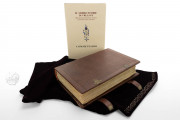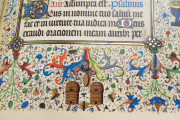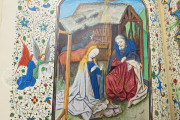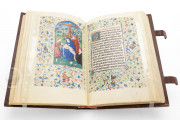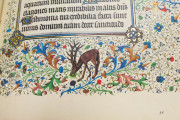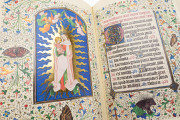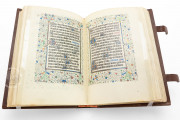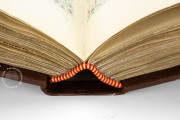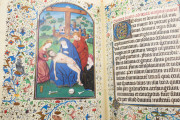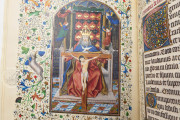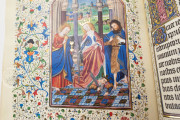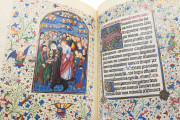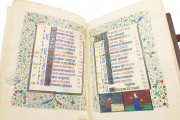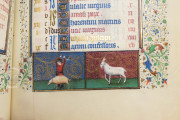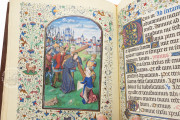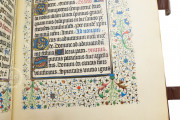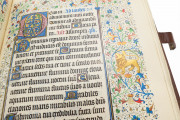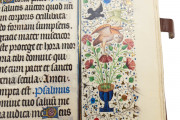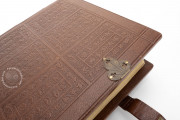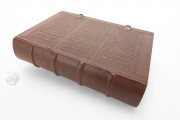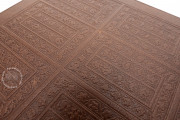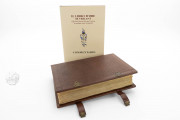A Christian prayer book made in Bruges around 1455-1460, the De Brou Hours is an outstanding example of a collaboration between Dutch illuminator Willem Vrelant and an anonymous illuminator well familiar with the art of Jan van Eyck. The anonymous illuminator was responsible for all but one of the twenty-three surviving full-page miniatures; Vrelant painted one full-page miniature and the engaging characters in the decorated borders of dozens of pages. The book was a gift from a mother to her son at his marriage.
The De Brou Hours contains the customary Latin prayers used in private devotion found in books of hours, including the Hours of the Virgin, the Office of the Dead, and the Penitential Psalms. It also includes a handbook on the Christian faith and three prayers in French.
Follower of Jan van Eyck
The principal illuminator of the De Brou Hours was a painter influenced by the style and who knew the compositions of the panel painter Jan van Eyck, who died in Bruges in 1441. His miniatures are characterized by many compositions based on those in the Turin-Milan Hours [link to 78] and a painting style that emulates that of the Netherlandish master.
The Virgin and Child on a Crescent Moon
Vrelant painted only one miniature, the Virgin and Child on a Crescent Moon, which opens the votive Mass for the Virgin for Advent. The subject was inspired in part by the description of the "woman clothed in the sun, and the moon was at her feet" in the biblical book of the Apocalypse. In Vrelant's miniature, golden rays emanate from the Virgin and Child, and the crescent moon is at her feet (fol. 90v).
Animals, Angels, and Drolleries
Vrelant's most characteristic contribution is the figures pictured in the decorated borders of the pages with miniatures (all versos) and their facing text pages. They include angel musicians, hybrid and monstrous creatures, and animals. On the pages where he painted the miniature are butterflies, a rabbit, an owl, and a porcupine (fols. 90v-91r).
Saints in Groups of Three
An unusual characteristic of the De Brou Hours is the grouping of the suffrages of saints into threes, with two prayers to male saints and one to a female saint forming each group. Each of the five miniatures in the suffrages shows a female saint (Barbara, Margaret, Catherine, Agnes, and Mary Magdalen) flanked by two male saints (fols. 162v, 165v, 168v, 171v, and 174v).
A Marriage Gift
The Hours of the Virgin are introduced, as is customary, by a miniature of the Annunciation to the Virgin (fol. 40v). Vrelant depicted a kneeling woman in the outer border. Three coats of arms occupy the lower border, probably those of the De Brou family (with scallop shells), the Jaquotot family (with bird claws), and the two families impaled. Since the prayers use the masculine for the devotee, it is presumed that the book was a gift from the groom's mother (depicted in the border) to her son when he married.
A Fifteenth-Century Binding
The current binding of blind panel-stamped black morocco—restored in the early nineteenth century and again in 1929—dates from the fifteenth century and is like the binding of the Llangattock Hours (Los Angeles, J. Paul Getty Museum, MS Ludwig IX 7), a manuscript on which the two illuminators of the De Brou Hours also collaborated.
Donated by the Queen of Etruria
In the eighteenth century, the De Brou Hours was in the possession of Michel Delacour-Damonville (1690-1756). On September 15, 1806, Maria Luisa (1782-1824), consort of Louis I, King of Etruria, donated the book to the Biblioteca Medicea Laurenziana.
We have 1 facsimile edition of the manuscript "De Brou Hours": Libro d'ore di Vrelant (Officium Beatae Mariae Virginis secundum usum romanum) facsimile edition, published by De Agostini/UTET, 2005
Request Info / Price

